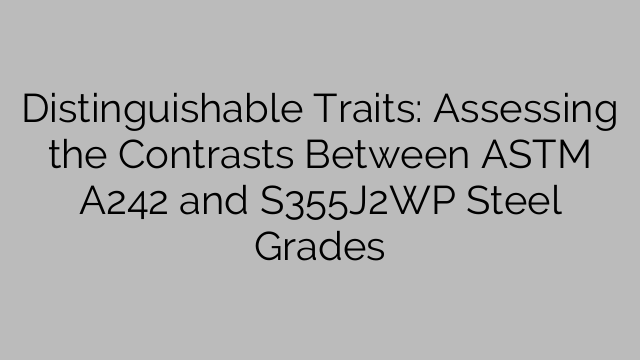Distinguishable Traits: Assessing the Contrasts Between ASTM A242 and S355J2WP Steel Grades
Steel is a versatile and essential material used in various industries worldwide. It comes in different grades and specifications, with each grade offering unique properties suitable for specific applications. In this article, we will explore and compare the characteristics of two popular steel grades, ASTM A242 and S355J2WP, highlighting their key differences.
ASTM A242 and S355J2WP are both weathering steel grades designed to provide high resistance to atmospheric corrosion, making them ideal for outdoor structures exposed to harsh weather conditions. Let’s delve into their distinguishing features:
1. Chemical Composition:
– ASTM A242: This steel grade primarily consists of elements like copper, chromium, nickel, and phosphorus, which contribute to its corrosion-resistant properties. The percentage composition of copper is exceptionally crucial, as it increases the steel’s atmospheric corrosion resistance by forming a protective oxide layer.
– S355J2WP: Comparatively, this grade contains a slightly higher amount of copper, along with other elements such as phosphorus, nickel, chromium, and manganese. The increased copper content enhances the steel’s weathering capability and ensures reliable protection against atmospheric corrosion.
2. 기계적 성질:
– ASTM A242: With a yield strength of 50,000 psi (345 MPa) and ultimate tensile strength of 70,000 psi (483 MPa), ASTM A242 provides moderate strength and excellent atmospheric corrosion resistance.
– S355J2WP: This grade offers higher strength compared to ASTM A242, with a minimum yield strength of 355 MPa and an ultimate tensile strength ranging from 470 to 680 MPa. Hence, S355J2WP exhibits enhanced structural stability in various applications.
3. Use and Applications:
– ASTM A242: Due to its excellent corrosion resistance, ASTM A242 is commonly utilized in architectural structures, such as bridges, buildings, and railway cars. Its aesthetic appeal, coupled with its superior weathering properties, makes it a popular choice for outdoor sculptures and monuments.
– S355J2WP: This grade is predominantly used in the construction of containers, bridges, and railway vehicles. Its high-strength properties and excellent resistance to corrosion make it suitable for various heavy-duty applications exposed to extreme weather conditions.
4. Surface Finish:
– ASTM A242: Steel plates made from ASTM A242 typically exhibit a dark brown or orange rust-like appearance, which is known as the patina. This characteristic physical appearance adds to the aesthetic appeal of architectural structures.
– S355J2WP: Similar to ASTM A242, S355J2WP steel plates also develop a distinct patina over time due to their weathering characteristics. This natural oxide film provides an additional layer of protection against corrosion, enhancing its longevity.
5. Availability and Cost:
– ASTM A242: This grade is widely available in the market and is relatively more affordable compared to some high-strength steel grades due to its moderate strength properties.
– S355J2WP: Due to its higher strength properties, S355J2WP steel plates may be slightly more expensive than ASTM A242. However, its enhanced strength and weathering capabilities justify the additional cost in certain applications.
In conclusion, while ASTM A242 and S355J2WP have many similarities as weathering steel grades, they have their distinct differences. ASTM A242 focuses more on exceptional corrosion resistance and aesthetic appeal, making it suitable for architectural structures. On the other hand, S355J2WP offers enhanced strength properties, making it a preferred choice for heavy-duty applications.
When selecting between ASTM A242 and S355J2WP, industry professionals must evaluate the specific requirements of their project, considering factors such as structural design, exposure to weather conditions, and budget constraints. Ultimately, both grades provide reliable corrosion resistance and have their respective advantages in different applications.

